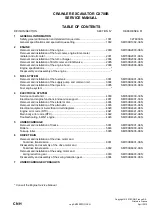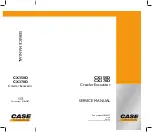
5-52
MAINTENANCE
EVERY 4000 HOURS
• Cylinders
1. Start the engine, let it run at a low-idling
speed for 10 minutes.
2. Maintain the engine at low idle, then
extend and retract each cylinder 4 or 5
times, without let them reach the stroke
end.
3. Run the engine at high speed, then extend
and retract each cylinder 4 or 5 times,
without let them reach the stroke end.
4. Set the engine back to a low idle, then
extend and contract all the cylinders 4 or 5
times to the stroke ends.
• Emergency shut-off valve (If equipped)
This operation is dangerous and requires
experience. Ask your sales or service
dealer for help.
If air is not released, the working
equipment could become slow in reacting
to the operation of the operator and show
unexpected behavior.
When removing plugs or screws, or when
disconnecting hoses, stand to the side
and loosen them slowly to gradually
release the internal pressure before
removing.
1. Place a pan under the hose (A) or (B) to
catch the waste oil.
2. Start the engine and run it at low idle.
3. Fully lower the safety lock lever to the
unlock position.
Boom
4. Hold the hose fitting (A) in place with a
wrench and slowly loosen the hose nut (1).
5. Slowly move the boom in the “Boom
lower” direction a little until there are no
more air bubbles coming from the hose
nut (1) joint.
6. Hold the hose fitting (A) in place with a
wrench and tighten the hose nut (1).
Arm
4. Hold the hose fitting (B) in place with a
wrench and slowly loosen the hose nut (2).
5. Slowly move the arm in the “Arm lower”
direction a little until there are no more air
bubbles coming from the hose nut (2)
joint.
6. Hold the hose fitting (B) in place with a
wrench and tighten the hose nut (2).
Summary of Contents for TB225
Page 1: ......
Page 7: ...0 5...
Page 12: ...0 10...
Page 13: ...1 1 SAFETY...
Page 52: ...1 40 SAFETY SAFETY SIGNS DECALS...
Page 53: ...1 41 SAFETY SAFETY SIGNS DECALS...
Page 54: ...1 42 SAFETY SAFETY SIGNS DECALS...
Page 55: ...1 43 SAFETY SAFETY SIGNS DECALS...
Page 56: ...1 44...
Page 57: ...2 1 CONTROLS...
Page 69: ...2 13 MEMO...
Page 105: ...2 49 MEMO...
Page 131: ...3 1 OPERATION...
Page 161: ...4 1 TRANSPORT...
Page 165: ...4 5 TRANSPORT HOISTING THE MACHINE Two point suspension Three point suspension...
Page 167: ...5 1 MAINTENANCE...
Page 189: ...5 23 MEMO...
Page 209: ...5 43 MEMO...
Page 231: ...6 1 TROUBLESHOOTING...
Page 250: ...6 20...
Page 251: ...7 1 SPECIFICATIONS...
Page 253: ...7 3 MEMO...
Page 254: ...7 4 SPECIFICATIONS MACHINE DIMENSIONS Cab MACHINE DIMENSIONS...
Page 256: ...7 6 SPECIFICATIONS MACHINE DIMENSIONS Canopy...
Page 258: ...7 8 SPECIFICATIONS OPERATING RANGES OPERATING RANGES...
Page 260: ...7 10 MEMO...
Page 262: ...7 12 SPECIFICATIONS Long arm Cab LIFTING CAPACITIES...
Page 263: ...7 13 SPECIFICATIONS Long arm Cab LIFTING CAPACITIES...
Page 264: ...7 14 SPECIFICATIONS Long arm Canopy LIFTING CAPACITIES...
Page 265: ...7 15 SPECIFICATIONS LIFTING CAPACITIES Long arm Canopy...
Page 266: ...7 16 SPECIFICATIONS Standard arm Cab LIFTING CAPACITIES...
Page 267: ...7 17 SPECIFICATIONS Standard arm Cab LIFTING CAPACITIES...
Page 268: ...7 18 SPECIFICATIONS Standard arm Canopy LIFTING CAPACITIES...
Page 269: ...7 19 SPECIFICATIONS LIFTING CAPACITIES Standard arm Canopy...
Page 270: ...7 20...
Page 271: ...8 1 OPTIONS...
Page 279: ...8 9 MEMO...
Page 284: ...8 14 OPTIONS CAB OPTIONS CAB OPTIONS 1 Front guard 2 Emergency hammer 3 Front light Right...
Page 295: ...8 25...
Page 296: ...8 26...


































